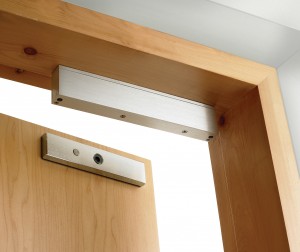 The increasing popularity of electronic access control systems is contributing to the market growth of electro-magnetic locking devices and electric releases, each of which is forecast to outperform the growth of mechanical locks over the next few years. Access Control systems are becoming increasingly popular because they provide a higher level of security while offering integrated opportunities with time management and building automation systems.
The increasing popularity of electronic access control systems is contributing to the market growth of electro-magnetic locking devices and electric releases, each of which is forecast to outperform the growth of mechanical locks over the next few years. Access Control systems are becoming increasingly popular because they provide a higher level of security while offering integrated opportunities with time management and building automation systems.
More Electro-Magnetic Locks are being used on Security, Escape and Fire Doors with no test evidence for performance, fire, environmental or security holding force. Electro-Magnetic Locks are now being used as part of security tests such as PAS24:2012 (Enhanced Security Performance Requirements for Doorsets and Windows in the UK) and plans in the future are to use them when testing to prEN 13637(Electrically Controlled Exit Systems). The Door and Hardware Federation (DHF) had concerns that manufacturers and distributors are supplying Electro-Magnetic Locks in to the market with no evidence to support that the products will perform as well as stated in the manufacturers catalogue. When tested it was found that a number of Electro-Magnetic Locks which claimed a holding force of 1200 lbs failed to reach this level. The DHF Technical Committee appointed Kevin O’Reilly, Operations and Technical Director for Securefast plc to Chair a sub-committee to compile a Technical Standard for Electro-Magnetic Locks, which is now complete and can be downloaded from the DHF website https://www.dhfonline.org.uk/publications-building-hardware.aspx.
The new DHF Technical Standard TS010:2014 for Electro-Magnetic Locking Devices is a performance requirement standard that will give specifiers and manufacturers of doorsets the confidence that the Electro-Magnetic locking device will perform to the required standard and covers Face to Face Fixed, Mortice, Shear and External Electro-Magnetic Devices. Although the testing method will test the holding force as a direct pull, the Electro-Magnet like many individual products that are tested to a product standard, will perform differently in a doorset test such as PAS24, however TS010 will give the manufacturer / distributor the confidence of consistency in Electro-Magnetic lock performance. The eight digit classification code includes the 6th digit for the holding force which falls in line with the security classification used by BSIA specifiers guide to Access Control Systems, the European Standard EN 50133-1 and the classification used by NSI in their Code of Practice for Planning, Installation and Maintenance of Access Control Systems NCP109.
Many of the Access Control Codes of Practice recommend a minimum holding force grade of 3kN (675 lbs), however TS010 allows mini Electro-Magnetic Locks to be tested and classified as these are still popular for low security applications. PAS24 testing will require a minimum holding force of 5kN which is grade 4 of TS010, equivalent to grade 2 of BSIA specifiers guide to Access Control Systems.
With many Electro-Magnetic Locks used on fire doors, with TS010 specifiers will be able to see from the classification code that the individual product has been tested or accessed for use on fire doors, which in the past has been ignored by many installers as no evidence is currently shown on the packaging, instructions or in manufacturer’s catalogues.
Within the Classification Code for TS010 specifiers can identify features of the product, such as the 4th digital shows if the product is supplied with safety straps and bolts whilst the 7th digit shows if the device is monitored either visually for example with an LED Indicator or audio using a buzzer etc. allowing specifiers to know what they are specifying.
Classification of DHF TS010
Digit 1 – Category of Use (only one grade used)
Grade 3 – for doors used by the public and others with little incentive to exercise care and with a chance of misuse to the door,
Digit 2 – Durability
Grade 5 – 50,000 cycles
Grade 6 – 100,000 cycles
Grade 7 – 200,000 cycles
Grade 8 – 500,000 cycles
Digit 3 – Suitable for use on fire / smoke doors
Grade 0 – Not intended for use on fire doors
Grade A – Suitable for use on smoke door assembly only
Grade B – Suitable for use on smoke / fire door assemblies
Digit 4 – Safety Bolts & Straps
Grade 0 = not supplied
Grade 1 = Safety bolts supplied
Grade 2 = Straps supplied
Grade 3 = Safety bolts and straps supplied
Digit 5 – Corrosion Resistance
Grade 1 – Up to 24 hours – Mild resistance
Grade 2 – Up to 48 hours – Moderate resistance
Grade 3 – Up to 96 hours – High resistance
Grade 4 – Up to 240 hours – Very high resistance
Digit 6 – Security – Holding Force
Grade 1 – holding force above 1000N (255 lbs)
Grade 2 – holding force above 2000N (450 lbs)
Grade 3 – holding force above 3000N (675 lbs)
Grade 4 – holding force above 5000N (1125 lbs)
Grade 5 – holding force above 7000N (1570 lbs)
Grade 6 – holding force above 10000N (2250 lbs)
Digit 7 – Security – Electrical Function
Grade 0 – No status indication
Grade 1 – Audio or visual signal
Digit 8 – Type of Device
Grade A – Face to face Fixed Electro-Magnetic Locks
Grade B – Mortice Face to Face Fixed Electro-Magnetic Locks
Grade C – Electro-Magnetic Shear Locks
Grade D – Electro-Magnetic External Locks
Based on the detailed information provided by the technical committee the DHF will shortly be producing the new standard TS010, which can be downloaded from the DHF website.
